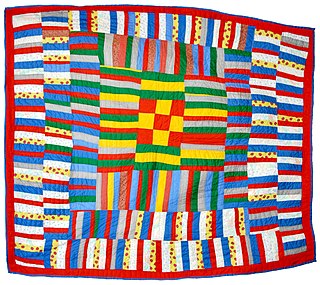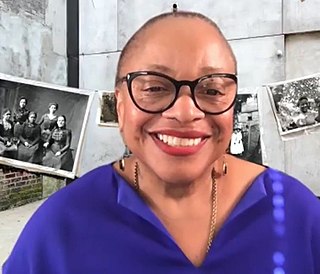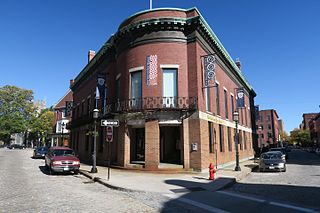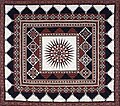
A quilt is a multi-layered textile, traditionally composed of two or more layers of fabric or fiber. Commonly three layers are used with a filler material. These layers traditionally include a woven cloth top, a layer of batting or wadding, and a woven back combined using the techniques of quilting. This is the process of sewing on the face of the fabric, and not just the edges, to combine the three layers together to reinforce the material. Stitching patterns can be a decorative element. A single piece of fabric can be used for the top of a quilt, but in many cases the top is created from smaller fabric pieces joined, or patchwork. The pattern and color of these pieces creates the design.

The NAMES Project AIDS Memorial Quilt, often abbreviated to AIDS Memorial Quilt or AIDS Quilt, is a memorial to celebrate the lives of people who have died of AIDS-related causes. Weighing an estimated 54 tons, it is the largest piece of community folk art in the world as of 2020. It was conceived in 1985, during the early years of the AIDS pandemic, when social stigma prevented many AIDS victims from receiving funerals. It has been displayed on the Mall in Washington, D.C., several times. In 2020, it returned to the AIDS Memorial in San Francisco, and can also be seen virtually.

The Canadian Museum of History is a national museum on anthropology, Canadian history, cultural studies, and ethnology in Gatineau, Quebec, Canada. The purpose of the museum is to promote the heritage of Canada, as well as support related research. The museum is based in a 75,000-square-metre-building (810,000 sq ft) designed by Douglas Cardinal.

Scotiabank Arena, formerly known as Air Canada Centre (ACC), is a multi-purposed arena located on Bay Street in the South Core district of Downtown Toronto, Ontario, Canada. It is the home of the Toronto Raptors of the National Basketball Association (NBA) and the Toronto Maple Leafs of the National Hockey League (NHL). In addition, the minor league Toronto Marlies of the American Hockey League (AHL) and the Raptors 905 of the NBA G League play occasional games at the arena. The arena was previously home to the Toronto Phantoms of the Arena Football League (AFL) and the Toronto Rock of the National Lacrosse League. Scotiabank Arena also hosts other events, such as concerts, political conventions and video game competitions.

Husky is a general term for a dog used in the polar regions, primarily and specifically for work as sled dogs. It refers to a traditional northern type, notable for its cold-weather tolerance and overall hardiness. Modern racing huskies that maintain arctic breed traits represent an ever-changing crossbreed of the fastest dogs.
Frank Havrah "Kaffe" Fassett, MBE is an American-born, British-based artist who is best known for his colourful designs in the decorative arts—needlepoint, patchwork, knitting, painting and ceramics. While still a child, Fassett renamed himself after an Egyptian boy character from the book Boy of the Pyramid by Ruth Fosdick Jones. His name rhymes with 'safe asset'.

The Textile Museum of Canada, located in Toronto, Ontario, Canada, is a museum dedicated to the collection, exhibition, and documentation of textiles.
Quilt art, sometimes known as art quilting, mixed media art quilts or fiber art quilts, is an art form that uses both modern and traditional quilting techniques to create art objects. Practitioners of quilt art create it based on their experiences, imagery, and ideas, rather than traditional patterns. Quilt art generally has more in common with the fine arts than it does with traditional quilting. Quilt art is typically hung or mounted.

The quilts of Gee's Bend are quilts created by a group of women and their ancestors who live or have lived in the isolated African-American hamlet of Gee's Bend, Alabama along the Alabama River. The quilts of Gee's Bend are among the most important African-American visual and cultural contributions to the history of art within the United States. Arlonzia Pettway, Annie Mae Young and Mary Lee Bendolph are among some of the most notable quilters from Gee's Bend. Many of the residents in the community can trace their ancestry back to enslaved people from the Pettway Plantation. Arlonzia Pettway can recall her grandmother's stories of her ancestors, specifically of Dinah Miller, who was brought to the United States by slave ship in 1859.

Deborah Willis is a contemporary African-American artist, photographer, curator of photography, photographic historian, author, and educator. Among her awards and honors, she is a 2000 MacArthur Fellow. She is currently Professor and Chair of the Department of Photography and Imaging at Tisch School of the Arts of New York University.
Women of Color Quilters Network (WCQN) is a national organization dedicated to preserving African American quiltmaking.
Ingo D. W. Hessel is a Canadian art historian and curator specializing in Inuit Art. The author of Inuit Art: An Introduction, Hessel has curated exhibitions for the Heard Museum in Phoenix, Arizona, the Museum of Inuit Art in Toronto, and the Art Gallery of Ontario in Toronto.

The New England Quilt Museum, founded in 1987, is located in downtown Lowell, Massachusetts and is the only institute in the Northeastern United States solely dedicated to the art and craft of quilting. It is the second-oldest quilt museum in the United States. It houses special and permanent exhibits, a library, a museum shop, and classrooms. Collections are strong in 19th century quilts, with a geographic focus on New England.
Malcolm Armstrong Harrison was a New Zealand clothing designer and textile artist.
Blake Debassige was a Native Canadian artist of the M'Chigeeng First Nation, born at West Bay on Manitoulin Island in Ontario on June 22, 1956, passed June 13, 2022. A leading member of the "second generation" of Ojibwa artists influenced by Norval Morrisseau, Debassige has broadened the stylistic and thematic range of this group. Debassige's paintings and graphics frequently investigate traditional Anishabek teachings about the nature of cosmic order, the cycles of the seasons, the interdependence of animal, plant and human life and the common principles at work in the world's great spiritual systems. He frequently relates these themes to highly contemporary problems such as the destruction of the environment, the alienation of native youth and family dysfunction.
Martha Cole is a Canadian artist. She is known for her work with textiles, landscape, and artist's books, addressing themes of inter-contentedness, sustainability, and protection of ecological diversity. She currently resides in Disley, Saskatchewan. Cole's high school art teacher, Helmut Becker encouraged her to pursue a career in art. She was an instructor in the Extension Division, Fine Arts and Humanities, University of Regina.

The International Honor Quilt is a collective feminist art project initiated in 1980 by Judy Chicago as a companion piece to The Dinner Party. The piece is a collection of 539 two-foot-long quilted triangles that honor women from around the world. Through the Flower, Chicago's not-for-profit organization, gifted the collection to University of Louisville Hite Art Institute in 2013 to be available for research and to exhibit.

The 150th anniversary of Canada, also known as the 150th anniversary of Confederation and promoted by the Canadian government as Canada 150, occurred in 2017 as Canada marked the sesquicentennial of Canadian Confederation.
Tau Lewis is a Canadian artist working in a variety of mediums including hand-sewn, carved and assemblage pieces.

Coronation Park is a park and veteran's memorial in Toronto, Ontario, built to mark the coronation of King George VI in 1937. Most trees are planted to honour the Canadian men and women who participated in the First World War and earlier wars, while others commemorate subsequent coronations of Canadian monarchs. Constructed on landfill on the shore of Lake Ontario during the Great Depression, many workers on relief were used. The park also has the Victory-Peace monument, located at the water's edge. To the east is HMCS York, the naval barracks; to the north is Fort York and the Fort York Armoury; and, to the west, is Exhibition Place, once the site of New Fort York.













